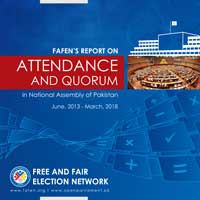- Enforcement of Assembly’s rules, presence of party leaders may improve Members’ presence in the House
- FAFEN suggests eight recommendations to reform the parliamentary rules of business
ISLAMABAD, April 8, 2018: The average attendance per sitting of National Assembly (NA) legislators declined by 13% over the last five years. Analysis of attendance patterns suggests a link of the falling attendance rate with weak enforcement of parliamentary rules of procedure and general disinterest among political leaders to participate in parliamentary business. The annual average attendance per sitting declined from 222 (65%) legislators during the first year to 193 (56%) legislators during the fifth year. Similarly, session-wise attendance average fell from 311 (91%) per sitting during the first session in June 2013 to 192 (56%) in the last NA session that was prorogued sine die in March 2018.
According to the official records, each NA sitting was attended by an average of 60% legislators. Only five sittings were attended by 301 or more legislators, while 42 sittings were attended by 251 to 300 legislators. A total of 212 sittings had an attendance between 201 and 250 legislators, 174 had an attendance between 151 to 200 legislators, 33 had an attendance between 101 and 150 legislators while two sittings were attended by less than 100 legislators. The attendance also fluctuated on various weekdays. The average attendance on midweek days (Tuesday, Wednesday and Thursday) is higher than the first and last working days of the week (Monday and Friday).
A comparison of the attendance patterns of legislators, the Prime Minister (PM) and the party Chief Whips (CW) reveals that average attendance declined during those sittings when the PM and the party CWs were absent. Similarly, weak application of parliamentary rules regarding leave of absence also seem to have a negative impact on attendance. According to the rules of procedure, the lawmakers may lose their seats if they stay absent from the proceedings for 40 consecutive sittings without leave of the Assembly. However, the House did not process motions for de-seating legislators who had remained absent for more than 40 consecutive days during the 2014 protest against the government.
Rules for taking leave require lawmakers to submit an advanced application to the Speaker for leave of absence. Enforcement of this rule remained weak as legislators did not incur any costs on disregarding it, which encourages the practice of remaining absent from the proceedings without notice. Examination of the Assembly’s verbatim records suggests that at least 13 lawmakers never applied for their leave of absence. As many as 12 of these lawmakers belong to the treasury benches PML-N and one to PTI. Federal Ministers Ahsan Iqbal, Khwaja Asif and Sheikh Aftab, Minister of State Usman Ibrahim, Speaker Sardar Ayaz Sadiq and Deputy Speaker Murtaza Javed Abbasi are among the legislators whose applications for leave of absence were never called out during five years. Nevertheless, the Speaker and the Deputy Speaker often had to perform important parliamentary duties in their chambers as well.
The low attendance often leads the opposition legislators invoking the quorum rule that requires a minimum of one quarter of the total membership to be present in the House for taking up business. Lawmakers drew the attention of the House to the quorum 145 times during 130 sittings since the inauguration of the incumbent Assembly. As many 15 sittings witnessed multiple quorum identifications. A total of 100 sittings had to be suspended or adjourned due to the lack of quorum, while at 45 instances, the required number was completed on the first headcount. FAFEN’s parliamentary observation reveals that the quorum was visibly lacking at numerous occasions but was ignored by legislators as well as the Chair. According to FAFEN’s observation, 345 (74%) out of 468 sittings commenced and concluded with less than one-fourth of the House membership.
To download Urdu Press Release, click here | To download complete report, click here


